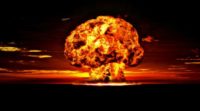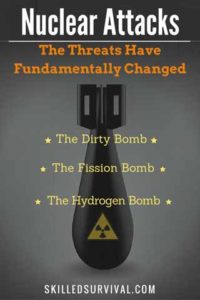
Welcome to our modern nuclear age…
- Where nuclear tensions are on the rise!
- While the FEAR of nuclear is fading…
Two Words: Complacency kills…
TOPICS IN THIS ARTICLE… ↓(click to jump)
- Our Cold War Past With Russia
- Current Modern World Threats
- 3 Nuclear Bombs & Their Effects
- U.S. Nuclear Attack Scenario
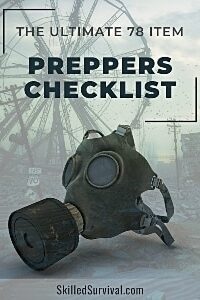
Want a free 78 item bug out bag checklist?
Enter your email below to instantly download this Complete Checklist PDF. No purchase necessary. 👇 👇Our Cold War Past With Russia
The Cold War started heating up (pun intended) back in the late 1940s when the Soviet Union detonated its first atomic bomb. A few years later, they detonated their first thermonuclear bomb. Thus began the Cold War between the United States and the Soviet Union.
At one point, both sides had in the neighborhood of 20,000 thermonuclear warheads pointed at each other.
This ridiculously high number of warheads ensured no significant attack by one side would leave the other side unable to prosecute Armageddon-level destruction the other.
The one thing that brought stability to the world was that both sides operated in their respective nation’s best interests. We could count on the Soviets only doing what was in their best national interest. By definition, incurring the wrath of 20,000 thermonuclear warheads was not in their “best” interest.
So, although there were many nuclear weapons pointed at each other over a long duration of time—the more weapons, the more unlikely either side would use them… So there was peace.
↓ Nuclear Crisis: The Escalation Of The Cold War
Today, we have a very different strategic nuclear warfare structure. Thanks to the fall of the Soviet Union and the various nuclear disarmament treaties that followed today, our deterrent force is a small fraction of what existed in 1985.
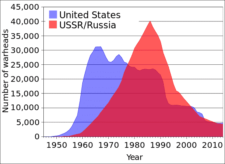
In reality, the fewer nuclear weapons in the world, the less unthinkable their employment becomes.
If a full nuclear exchange scenario destroys all life as we know it – most rational nations won’t prosecute such an attack. However, if that exchange is viewed as somehow manageable and losses seem acceptable, the unthinkable becomes a tactic to be employed.
During the Cold War, our enemy was a communist, authoritarian, atheistic society. The Soviet Union always put the State before the individual, family, and God. In fact, communist nations removed all references to God from the public consciousness.
An authoritarian government needs to deny the existence of God and forbid the worship of any deity. All trust must be in Government, and no deity can muddle with the people’s priorities. The State must come first.
Or, as Vladimir Lenin once said:
While the State exists there can be no freedom; when there is freedom there will be no State.
Since the Soviets denied the existence of God, their nuclear doctrine was not based on religious beliefs – not at all. The United States, although a nation with freedom of religion, did not inject God into its defensive nuclear doctrine.
The New Nuclear Attack Scenario
Today, our newest, most formidable enemy – radical Islam – DOES interject religious doctrine into their war-fighting strategy. Today, if a radical Islamic state, such as Iran, is allowed to develop a nuclear weapon.
They have publicly indicated they would use it against their enemies, namely Israel and the United States. They are not afraid of retaliation or of taking losses in their nuclear struggle.
Their citizens are taught every person who dies in defense of Allah will be rewarded in the afterlife. They do not fear death…for them, it is a doorway to a greater existence. This concept effectively stands the traditional nuclear warfare doctrine on its ear. Suddenly, nuclear retaliation is no longer feared.
It may even be desired as a means of martyrdom. The deterrent effect that worked so well with the Soviets (and to a lesser extent with the Chinese) is reduced to insignificance.
For those who believe thermonuclear weapons are too advanced for a Third World nation to develop, I would say this:
Nuclear weapons were invented before color TV, before the garage door opener, before the microwave oven, before micro-electronics – even before the transistor.
They were invented a full decade before we even put a satellite in orbit. We’re talking 1940’s technology.
So, let’s examine the three main nuclear weapons we could face.

Want a free 78 item preppers checklist?
Enter your email below to instantly download this Complete Checklist PDF. No purchase necessary. 👇 👇3 Nuclear Bombs & Effects
1. The Dirty Bomb
It’s not expensive or technologically daunting. Damn, nearly anyone could build one of these – if you can access the radioactive waste. In this device, a conventional explosive bomb is wrapped in layers of radioactive waste.
We’re not talking plutonium here. We’re talking about the radioactive waste that comes from medical and industrial waste streams. These substances are radioactive. They are dangerous.
They can make one very ill and even kill with prolonged exposure and can cause cancers, leukemia, and all sorts of nasty maladies if exposed to them.
The explosives detonate and essentially blow the radioactive waste into billions of tiny fragments, which can be carried by the wind and cover an area as large as several city blocks. This area will be hot – otherwise known as contaminated.
Anyone passing through this zone could have long-term health implications.
If the radioactive material used is highly radioactive, say waste fuel elements from a commercial or research nuclear reactor, then we’re talking about serious and immediate radiation poisoning for all those in the immediate area.
Death in hours or days due to massive cellular damage versus years with cancers. The good news about the Dirty Bomb is it has a very limited range. It can only cover a few city blocks; after extensive decontamination, the area can be safe again relatively quickly.
Also, since it has very localized effects, the best thing to do in the event of a Dirty Bomb detonation somewhere in your city is to hunker down, stay indoors, not travel, and not go outside.
Go into your basement and listen to the radio and TV for reports of where the contamination is located. Don’t try to flee the city without any information.
Murphy’s Law states that you will leave the safety of your home and walk right into the “Hot Zone” trying to save yourself. So Stay Put.
↓ What is a dirty bomb?
2. The Fission Bomb
The Fission (or Atomic) Bomb is the type that was dropped on Hiroshima and Nagasaki at the end of World War II. Fission bombs are generally not large nuclear weapons.
Although a couple of hundred thousand people died in Japan at the hands of fission bombs. But they were firecrackers by thermonuclear standards (We’re talking thousands of tons of TNT versus millions of tons of TNT).
The Fission bomb derives its name from the process of nuclear fission or the splitting of atoms.
Nuclear fission occurs when a sufficiently large mass of enriched and highly radioactive isotopes, such as Uranium-235 or Plutonium-239, reaches what is known as critical mass.
At critical mass, the radioactive decay taking place within the atoms of the fissile material causes what is known as a chain reaction.
Radioactive particles from the decay of one atom slice through several other atoms, splitting them and releasing a cascade of more particles, which split even more atoms. The chain reaction grows, resulting in heat, light, and nuclear radiation in the form of beta, alpha, and gamma rays.
So How Does The Bomb Reach Critical Mass?
The Hiroshima bomb, called Little Boy, used two separate masses of U-235, one to act as a projectile, the other the target. This is called the Gun-tube configuration.
An explosive charge detonates and drives the projectile mass of uranium down the tube at a high velocity.
Where it strikes the target mass with so much kinetic energy that they essentially “melt” together due to the heat produced in the collision. This combined mass is above the critical mass, and a chain reaction begins.
The Nagasaki Bomb, called Fat Man, was of the implosion configuration.
Explosive “lenses surround two hollow half-spheres of Plutonium-239.” A small mass called the initiator, made of polonium and beryllium, is in the middle of the sphere. The initiator assists in starting the chain reaction.
There is also a layer of uranium-238 between the plutonium and the initiator, which acts as a radioactive insulator and neutron reflector. The mass of plutonium, with the initiator inside, is enough for critical mass. But not in the hollow spherical configuration.
The density of the plutonium is too low, and the uranium shielding prevents the passage of neutrons.
During detonation, the shaped charges force the explosive force into the “core,” squeezing and compressing it equally on all sides to drive the sphere into itself, increasing the density, so the resultant mass becomes critical – thus, the chain reaction begins.
It is more complex than the gun tube but more efficient, generating a larger explosive force. This overall design is also critical for the next type of weapon.
↓ This Is How A Nuclear Bomb Works

Want a free 78 item preppers checklist?
Enter your email below to instantly download this Complete Checklist PDF. No purchase necessary. 👇 👇3. The Thermonuclear Bomb (a.k.a. Hydrogen Bomb or Fusion Bomb)
This weapon uses the energy released during nuclear fusion. Nuclear fusion occurs when atoms of a substance are fused together to form more complex atoms – such as hydrogen, into helium. The fusion process requires heating these elements to millions of degrees to start the fusion reaction.
When nuclear fusion begins, the energy released is often larger than the energy required to initially raise the elements to the initiation temperature.
Since there are very few ways to heat a substance to ten million degrees, at the heart of a thermonuclear bomb is a small fission bomb. The fission bomb detonates, releasing heat, radiation, and neutrons.
These bombard a special container of deuterium/tritium – heavy isotopes of hydrogen. The deuterium/tritium is heated and bombarded with neutrons.
At the right temperature and neutron flux, the fusion reaction begins, and a lot of energy is released. The interesting thing about both the fission bomb and the fusion bomb is that they are simply heaters.
When they detonate, they generate millions of degrees of heat.
This is unlike regular explosives, where the explosive power is generated by the production and expansion of high-pressure gas. Nukes don’t produce gas in any significant quantity, but they produce heat, light, and radiation.
If you look at the detonation, the light will instantly blind you—you can’t blink fast enough to shut it out.
In fact, the heat is so intense and sudden that it raises the air temperature around the bomb from 70 degrees F to 10,000,000 degrees F in milliseconds.
The air, like any gas, expands due to the high temperatures. It also ionizes, turning into energized plasma.
This superheated gas expands rapidly outward, creating a shockwave moving at nearly the speed of sound – a shockwave still several tens of thousands of degrees F. This shockwave and the heat it carries is what levels cities and digs craters into the ground.
In fact, once the shockwave has used up most of its energy, a vacuum is left at the center of the explosion. And now the air races back at near-supersonic speeds from all directions to fill that vacuum.
This stirs up debris and soil as it moves, and when it reaches the dead center of the explosion, the whole mass rises upward to form the mushroom cloud.
Now, here’s what’s interesting – if the bomb were to detonate in the vacuum of space, there would be nearly no shockwave or mushroom cloud.
Here’s a video that shows The Evolution of the Nuclear Bomb:
↓ Animation shows the deadly evolution of nuclear weapons
For even more information on Nuclear Physics and Atomic Theory, read this.
↓ Nuclear Bomb: How it Works in Detail. Atomic vs Hydrogen bomb
Electromagnetic Pulse & The Side Effects
Another interesting phenomenon of nuclear detonation – fission or fusion – is electromagnetic pulse (EMP). EMP is a pulse of electromagnetic energy that is generated at the time of detonation.
It races outward at near the speed of light in a line-of-sight fashion – so if it occurs high in the atmosphere, it can cover a very wide area. This blast of electromagnetic energy will induce voltages in an electric or electronic circuit that is not shielded.
It is just like the voltage induced in the windings of a generator – but many, many orders of magnitude more powerful. These voltages and the induced amperages will burn out any electronic components in the line of sight that are not shielded by EMP protection.
↓ Nuclear Explosion in the Sky | National Geographic
What Would A U.S. Nuclear Attack Scenario Look Like?
Well, it would not look like an attack the Soviets might have mounted.
The Soviet attack would have been a coordinated affair, using submarine-based SLBMs to quickly take out our missile fields, command control assets, ICBMs to take our localized defenses and military bases, and then bomber sorties to pound our remaining forces and major cities into rubble.
Thousands of warheads would have rained down on us in a matter of thirty to forty minutes, with bombers mopping up the remnants over the next 24 hours.
Of course, we would have been doing the same to them – which is why it never happened. No. Today’s nuclear attack scenario will likely come from nowhere – out of the blue, with no warning. Most likely, the delivery vehicle will not be an airplane or missile.
My Best Guess
If I were guessing how a terrorist nation would launch a nuclear attack on US soil, I’d bet on either a Ford F-150 with a camper shell over the bed (or Chevy Silverado – for those Bowtie fans) or a cargo container ship.
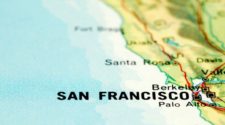
The terrorists could detonate the bomb before anything is even unloaded and well before customs inspect the hundreds of containers on the ship.
The same goes for Great Lakes ports as well, such as Chicago, Milwaukee, Detroit, Buffalo, etc.
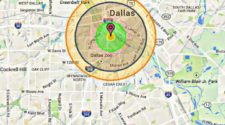
I truly believe if a terrorist organization ever prosecutes a nuclear attack scenario, the first indication something is wrong is when the ambient temperature hits 10 million degrees.
- Nuclear explosion maps can better understand how a nuclear detonation in your nearest city could affect you.
- And read this article to learn how to survive a nuclear attack.

Prepare, Adapt & Overcome,
P.s. - I just found out 2 out of 3 Americans don’t feel prepared for a 3 day disaster!!!
I guess this goes to show how modern society continues to embrace ‘living a fragile life.’ What’s crazy is… it’s so easy to fix.
To make sure YOU have the basics, watch our FREE training on “10 Simple Steps To Basic Preparedness” that shows you HOW.
Nothing crazy here… this isn’t doomsday prepping... just the basics every responsible adult should have before a disaster strikes.Why You Can Trust Skilled Survival...
Go here now to review a full breakdown of:
- Who We Are
- Our Credentials
- Our Mission
- & Product Recommendations...
Here are a few highlights of our teams credentials & certifications:
- Certified Member of a Mountain Search & Rescue Organization
- Plant Emergency & Safety Leader for a Major Food Manufacturer
- Member of the 10TH Mountain Division Hut Association
- Certifications: Avalanche 1, WFR, CPR
- Official Gear Tester for Numerous Outdoor Gear Companies
- Countless Multiday Backpacking trips into Remote Wilderness
- Bachelor's Degree In Mechanical Engineering
- Bachelor's Degree In Civil Engineering
- Bachelor's Degree In Biomedical Engineering
"It takes 20 years to build a reputation and five minutes to ruin it." - Warren Buffett
We're fully aware that trust is NOT something you GET but is EARNED.
And we'll continue to earn YOUR trust through our forthright and honest approach with each new Blog Post, Guide & Product we create...
P.s - I just took this FREE 60-second 'Readiness Score Quiz'👇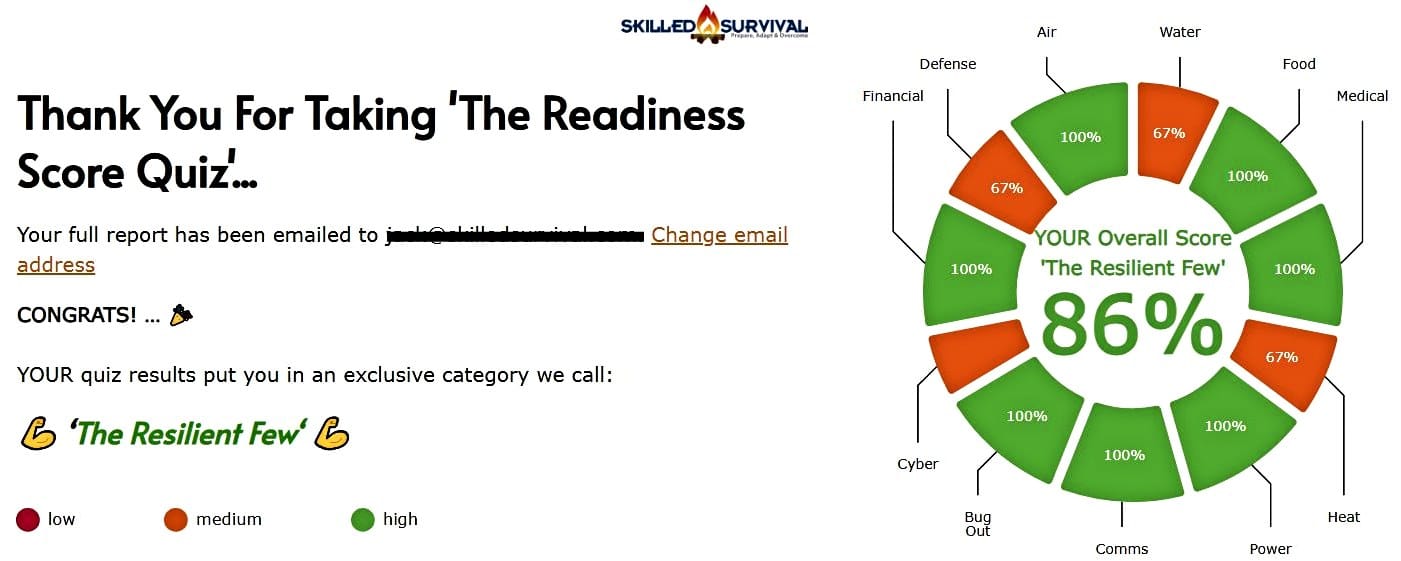
AND... I've still got a few gaps in my preps...🤔 But at least, I'm not part of 'The Fragile Masses'. 👍 Find out where YOU stand by answering a few questions...
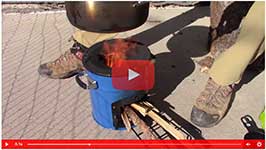
Recommended Reading
Long Term Fuel Storage For Survival Emergencies
Long term fuel storage is crucial in emergencies, but fuels must be stored properly especially long term gasoline storage.
How To Store Seeds For Wise Prepping & Survival
When seed saving and seed storage, you must do it right. Learn how to store seeds so they'll thrive the next planting season.
Common Everyday Carry Mistakes YOU Must Avoid At All Costs
The only person qualified to build YOUR Best Everyday Carry (EDC) is YOU. To do it right, you must avoid these common mistakes and pitfalls.
Strategic Relocation: How To Find A Safe Pace To Live
Use strategic relocation to find a safe, defendable location to call home. Your choice of location WILL determine your survival fate.
Nuclear Fallout Map: Would I Survive A Nuclear Bomb?
Have you seen this nuclear fallout map? Or run a nuclear simulation to see the damage a nuke would do to your city? If not, check this out.
Homestead Survival: How To Master Plan Your Safe Haven
Use this simple 6 homestead survival plan to successfully survive (and thrive) even if the world falls into chaos...
